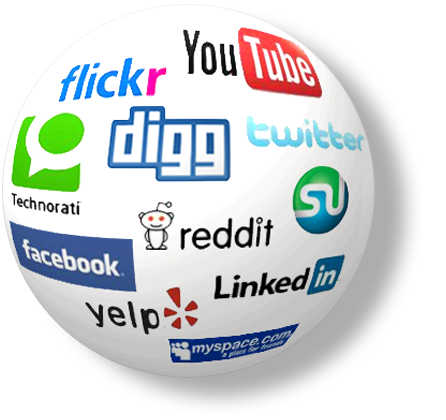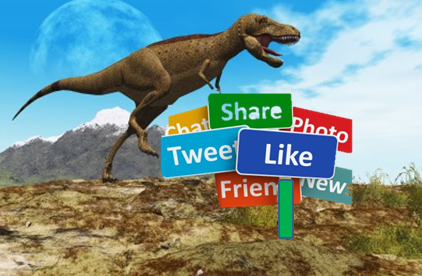How smart and savvy is your government agency on social media? Has it staked out a strong social presence in cyberspace, or is it more like a meandering dinosaur in Jurassic times?
It should be evident by now that all public sector agencies need to strategically leverage social media in the 21st century Digital Age as part of any comprehensive communications plan.
In short, implementing an effective social media strategy simply makes good business sense, especially considering the hyper-pace of new and evolving mobile digital and virtual technology in our professional and personal lives.
That’s why my #4 recommended public sector priority for calender year 2015 is:
- Leveraging social media on a diverse range of platforms, including non-traditional ones.
No government agency wants to be known as a “social media dinosaur” at the dawn of a new millennium.
Benefits of Being “Social”
Social media (or “social” for short) has proven to be an invaluable asset to countless organizations regardless of whether they are large, small or mid-sized. The many benefits of adopting an effective social strategy include, but are not limited to, the following:
- Increasing public engagement and website traffic.
- Enhancing recruitment and hiring of the best available talent.
- Fostering transparency while building a bigger following.
- Improving public and stakeholder relations, loyalty and trust.
- Bolstering an agency’s brand image and mission-driven reputation.
- Contributing to effective crisis communication by containing any online media firestorm from becoming a viral conflagration.
These are just a few of the many reasons why beefing-up social should be a public sector imperative in the year ahead. But some old-school managers and supervisors still don’t get it. They fail to comprehend the basic premise and benefits of smart social strategies.
Although most agencies have established some social presence, many still lag in proactively leveraging multiple platforms to reach the broadest audience possible. This means moving beyond just Facebook and Twitter.

No One-Way Street
It’s important for agencies to recognize that they should not be on social media simply for the sake of it. To the contrary, any agency first needs to adopt a smart social media plan with well defined goals and objectives to obtain the best results.
Yet it’s vital for public servants to understand that social media is not a one-way street. There’s much more to being social than merely getting your agency’s message out via a tweet. The real key can be summed up in one word: Engagement.
It’s all about engaging the public, customers and stakeholders to improve their experience with your agency. Your social media game plan should be based on the popular premise: Help me help you!
This means strategically leveraging social media to solicit and respond to public questions, concerns and complaints in a more effective, efficient and expeditious manner. Strive to be more conversational and less bureaucratic. Try to avoid using boilerplate jargon and legalese.
Gov Experts Chime In
To gain further insights into how government can best leverage social media in the year ahead, I spoke to a few federal experts. Here’s what two of them had to say…
Corina DuBois is Chief of New Media at the U.S. Department of State, Bureau of Consular Affairs. She advises the following:
- “When we think of maximizing social media for government, at any level, we especially need to consider how this benefits our customers, not just our agencies.”
- “Some may think ‘maximize’ means putting out more tweets, or getting more “Likes.” In reality, making the best use of social media means having a long-term strategy focused on true engagement with the public in a transparent and personable tone.”
- “Your content and approach should be assessed according to what is working for your audience. If you have folks that trust you as a reliable, official, and approachable source, you have much more than raised your metrics — you’ve expanded your reach to an audience using the platforms they trust for timely and relevant information.”

Scott Horvath is the Web and Social Media Coordinator for the U.S. Geological Survey (USGS). He told me this:
- “It should be clear to any organization that social media is a massive driving force in the customer service and communications landscape.”
- “However, rather than making ‘social media’ by itself a top priority, organizations should look more broadly across all of their efforts and figure out how social media can support those things that they already do well, or still need improvement.”
- “In addition, they should push toward better customer service using their social media efforts.”
- “To this day, I still see organizations responding to every tweet/post with a standard, Email us at… response, rather than handling the issue right then and there. People expect organizations to evolve with them, not retreat and rely upon the days of yore.”
So how active is your agency in effectively leveraging social media on multiple platforms, including non-traditional ones?
Moreover, what can your agency do to improve upon its social media strategy to better serve the public while achieving mission-driven results?
DBG
*** PLEASE SHARE YOUR COMMENTS BELOW ***
AUTHOR’S NOTE: This is part four in a five-part series examining the top public sector priorities recommended for 2015. Prior posts focus on strengthening cybersecurity (#1), fostering workforce diversity (#2), and implementing work flexibility programs (#3). Stay tuned for the fifth and final post of this series next week.
*** All views and opinions are those of the author only and not official statements or endorsements of any public sector employer, private sector employer, organization or political entity.
David B. Grinberg is part of the GovLoop Featured Blogger program, where we feature blog posts by government voices from all across the country (and world!). To see more Featured Blogger posts, click here.





Nice post, David! I think you touched on an important point of agencies not having social media accounts just to say they do, but to actually utilize them to enhance public engagement and realize the many other benefits you laid out. I think it’s also important to have a integrated plan across various social platforms to expand your reach and reinforce your brand/image. Thanks for sharing!
Matthew, thanks so much for your valuable feedback — which is appreciated!
This is really interesting, David. Thanks for making these points – I particularly like the notion of thinking about social media as a service to clients/consumers. Sure, it’s entertaining and informative, but it should also serve to help the consumer-driven mission of the agency, whatever that may be. Relatedly, you might want to check out my recent post on the Department of the Interior’s Twitter! https://www.govloop.com/following-interior-twitter/
Thanks Camilla, you raise many good points. I will definitely check out your post. I appreciate your comments!
David, where do you see the drive to go social intersecting with the topic of the first post in your series, cybersecurity. The recent attacks on government systems by hackers definitely highlights the conservative nature of many agencies’ social media policies/strategies (if they even have them). Any advice on how to succeed in engaging in open dialogue and making new connections when there is such fear about information security and maintenance?
Thanks for the sharing your important insights, Dave, you raise several good questions. I certainly don’t have all the answers, but I suggest using your best judgment and closely coordinating with your IT team. Also, recall FDR’s timeless refrain, “The only thing we have to fear is fear itself.” I assume he would still say that in the Digital Age. Perhaps some IT experts on GovLoop like founder & president, Steve Ressler, could chime in on your questions @sressler. Steve, what say you, kind sir?
Dave Barton, per your question above, check this out from DigitalGov: https://www.digitalgov.gov/2015/01/27/new-inter-agency-social-media-cyber-vandalism-toolkit-launched/
DAVE, one more news item to share from NextGov regarding cloud security for Gov: http://www.nextgov.com/cloud-computing/2015/01/new-fedramp-standards-provide-glimpse-how-feds-will-protect-sensitive-data-cloud/103971/
My agency leverages social media on multiple platforms to reach the public as they are our primary customers, but it needs to improve its social media strategy by changing the way it communicates with the employees. This will help strengthen internal relations and break the departmental boundaries within the agency. I know a lot about how my agency’s external impact but very little about its internal impact.
Cynthia, thanks very much for your valuable feedback, which is appreciated. I’m not sure that many agencies use social media for internal communication purposes. I think most agencies still use e-mail or IM for those purposes. Perhaps GSA, OPM other another federal agency should consider a pilot program to assess the efficacy of social media use for internal communications. It may help break down those subborn “silos” that many public servants view as a hindrance to internal communication, information sharing and more staff collaboration across divisions.
I totally agree with you about engagement being key, but I also understand certain agencies’ (even those with a huge customer service side) reticence to more freely engage with the public. It’s a balancing act, wanting to be as helpful as possible but nervous about possible backlash if the interactions aren’t executed flawlessly. The “help me help you!” idea is a great one (I personally love when I can tweet at some company’s customer service and get a response faster than I would by calling), but some agencies are dealing with much more sensitive issues than others. I don’t blame them for playing it safe because dipping a toe in that pool could just cause a dam to break.
Anxiety about change is normal and understandable, but we have to push beyond it. Just like we trust employees to talk with stakeholders at the public counter, by phone, or in email, we need to have the same conversations via social media. Yes, the difference is that the conversation is documented for the world to see – but that is also the benefit, because a broader audience has the benefit of the insights in the conversation, too. It’s just the next evolution of communication and it’s incredibly positive.
Lori, thanks so much for sharing your important insights on this topic –with which I agree, per my reply to Mackenzie. The bottom line is that whether gov likes it or not, the world has moved into the Digital Age in which social media is a key form of communication. Agencies that avoid social media can run but they can’t hide forever. The public expects and deserves quality customer service and social media is one way to provide it. I’ve found that citizens who ask questions via social media are very happy and appreciativr to get a quick response from Big Gov — even if that response is that you have to check with subject matter experts or attorneys and get back to them.
Mackenzie, I appreciate your valuable view on this topic. You raise some good points. When, how and how much to engage on social media should be made on an agency by agency basis. It’s also important to vet social media plans through the agency’s Office of Legal Counsel. However, some agencies which are reticent about using social media need to take step into the 21st century Digital Age. One thing about government and entrenched bureaucracy is that it tends to be too risk averse and afraid of change. Like anything, social media for government poses risks, but so does dealing with the news media. You know that old saying: no risk, no reward.
I agree… no growth without evolution… the internet/web presence changes so quickly… wow. thanks for this timely article!!!
Chrisitina, thank YOU for taking the time to share your valuable opinion on this topic. You raise a good point about change occuring quickly. This means that agencies which shy away from social media will only have more ground to cover later when new leadership requires them to catch up.
These are great points, David. Thanks for sharing your insight on engagement!
Thanks for the kind words, Angela, which are appreciated.